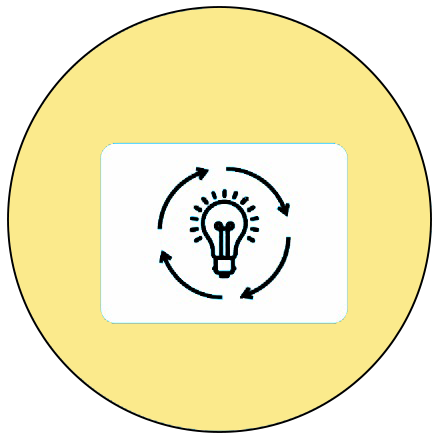
Subtraction of 2 Digit Numbers
Week 3
Learning Outcome
Performs subtraction of 2-digit numbers fluently using flexible strategies.
 Objective
Objective
Children will be able to use different strategies to show and solve subtraction problems involving two-digit numbers, with and without regrouping, using the number line and procedural method.
 Prerequisites
Prerequisites
- Children can perform single-digit subtraction.
- The teacher can have a simple check for understanding at the beginning of the lesson by asking the children to solve a few double-digit subtractions using manipulatives or drawing.
 Pre-teach Vocabulary
Pre-teach Vocabulary
Children should be familiar with the terms such as, take away, less, before, remaining, subtrahend, and minuend.
Introduction: Strategies to Solve Subtraction Problems
The teacher could begin the class by saying, ‘today we are going to learn two different strategies to solve subtraction problems with two-digit numbers.’
We will use:
- A number line to jump backward.
- The step-by-step column method (procedural method).
And then ask,
- What does it mean to take away?
- When would we need to regroup in subtraction?
Materials required:
- Whiteboard/Chart paper
- Number line strips (individual and large display)
- Base-ten blocks (optional for concrete practice)
- Pencils and erasers
- Subtraction worksheets (with mixed regrouping and non-regrouping problems)
- Math notebooks
Teaching Method: I Do – We Do – You Do
I DO (Teacher Modeling):
Number Line Strategy
Model with: 47 – 23 =?
- Start at 47 on the number line.
- Hop back 20 (two jumps of 10).
- Hop back 3 more.
- End at 24.
- Say: 47 minus 23 equals 24. I used big jumps for Tens, and small jumps for ones.
Procedural (Column) Method – No Regrouping
Model: 54 – 21=?
54
− 21
______
33
- Subtract ones: 4 – 1 = 3
- Subtract tens: 5 – 2 = 3
Procedural (Column) Method with Regrouping
Example: 52 – 38
Step 1: Write the problem in vertical form.

Subtract the Ones Place
We look at the ones place:
2 – 8 is not possible because we can’t subtract 8 from 2, so we need to regroup.
Step 2: Regroup a Ten
- We regroup 1 ten from the tens place in 52.
- That leaves 4 tens (instead of 5).
- We add 10 ones to the existing 2 ones:
10 + 2 = 12 ones
Now the problem looks like this:

Step 3: Subtract Ones and Tens
- 12 − 8 = 4 (ones place)
- 4 − 3 = 1 (tens place)
Final Answer:

We Do (Guided Practice):
Let the children work with the teacher’s guidance.
Number Line
Problem: 63 – 25 =?
- Ask: Where do we start on the number line?
- Answer: 63
- Help the children to count back: 2 jumps of 10 and then take 5 jumps of 1.
- You land on 38. So, the answer is 63 – 25 = 38
Procedural Method
Problem: 41 – 16 =?
Problem: 41 – 16 =?
41
–16
_____
?
______
Ask guiding questions to involve the children:
‘Can I subtract 6 from 1?’
No, I can’t.
‘What do I do when I can’t?’
We regroup (borrow) from the Tens place.
Explain and model regrouping:
Take 1 Ten from the 4 (which becomes 3), and add 10 Ones to the 1.
Now you have 11 – 6 in the Ones place and 3 – 1 in the Tens place.
Solve step by step with the children:
11 – 6 = 5
3 – 1 = 2
Final Answer:
41 – 16 = 25
You Do (Independent Practice):
Provide 6 mixed problems:
- 3 without regrouping
- 3 with regrouping
Children will solve:
- 3 using number line (drawn or paper strip)
- 3 using procedural method
Video: Strategies to solve subtraction problems – Coming soon
ISL Video: Strategies to solve subtraction problems – Coming soon
LTM: DIY Flashcards – Coming soon
LTM: Printable Flashcards – Coming soon
Activity 1: Jigsaw Puzzle to Identify the Image
Objective:
To find the difference between two, two digit numbers by grouping or regrouping and solving the puzzle to get the hidden image.
Importance of the activity for children:
Helps in developing:
- Fine motor skills (Holding the piece of board, hand-eye coordination)
- Cognitive skills (Concentration, problem-solving)
- Social skills (Cooperation, waiting for their turn, playing together)
- Language skills (Articulating, concepts formation like ‘difference, take away’)
- Emotional skills (Builds confidence in numeracy, promotes a sense of achievement that boosts self-esteem, and encourages pride in learning new skills)
Resources required:
- Jigsaw puzzle cardboard pieces with the question on one set of cardboard pieces (10)
- Cardboard pieces with the answer printed on the picture (10)
Setting for the activity:
The activity can be done indoors or outdoors depending on the space availability.
Type of activity: Group activity
Preparation of activity:
The teacher will make sure the set of pieces is ready.
Role of the teacher: Demonstrator, observer, and facilitator.
Preparation of the puzzle:
- First the jigsaw puzzle of 12 cardboard pieces are made with the subtraction sum. In another set of cardboard pieces, answers are written /printed.
- Make them into one full pack with question pieces and answer pieces.
Procedure:
- The class is divided into groups of 4 Children.
- Each group will get a pack of two sets of puzzles, one with a question and the other one set with the answer printed on a part of a picture.
- The group will solve the puzzle by finding the answer for the subtraction (using different strategies), arranging the answers in the written way of questions, and identifying the hidden picture.
Observations:
The teacher observes the children engaged in the activity to find:
- Are the children able to solve the two-digit subtraction problems using appropriate strategies such as regrouping, number line, or column method?
- Are they able to demonstrate understanding of the subtraction concept by correctly matching the question pieces with the corresponding answer pieces?
Suggested Variations:
The teacher can incorporate visuals and props to make the lesson more engaging.
(This is not a variation but a must!)
Conclusion:
Children would be able to solve subtraction problems creatively using the manipulatives.
LTM: Puzzles – Coming soon
Activity 2: Crossword Puzzle
Objective:
To apply the concept of subtraction to solve the crossword puzzle.
Importance of the activity for children:
Helps in developing:
- Gross motor skills (Sitting erect, bending)
- Fine motor skills (writing, holding a pencil)
- Cognitive skills (solving the puzzle, associating facts, filling the number name of the answer)
- Social skills (cooperation, waiting for their turn, discussing)
- Emotional skills (Builds confidence in numeracy, promotes a sense of achievement that boosts self-esteem, and encourages pride in learning new skills)
Resources required:
A4 sheet with the crossword puzzle.
Setting for the activity:
The activity can be done indoors or outdoors depending on the space availability.
Type of activity: Group activity
Preparation of activity:
The teacher will make sure about the availability of resources.
Role of the teacher: Demonstrator, observer, and facilitator.
Procedure:
- The class will be divided into groups of 3 children.
- Each group will get a puzzle sheet. They have to solve the subtraction sums and fill up the puzzle sheet using the clues given.
Observation:
The teacher observes the children engaged in the activity to find:
- Are children able to solve subtraction problems correctly using appropriate strategies?
- Can they convert numerical answers into number names correctly?
Suggested Variations:
- The teacher can start the activity by demonstrating with different numbers.
- The difficulty level can be increased by increasing the number of gaps.
Conclusion:
Children would learn to subtract two-digit numbers using different strategies.
LTM: Crossword puzzle – Coming soon
Assessment
The teacher can give the practice worksheet to the children which can be followed by an assessment worksheet.
Worksheet: Practice worksheet- Coming soon
Worksheet: Practice worksheet (Enlarged) – Coming soon
Worksheet: Assessment worksheet – Coming soon
Worksheet: Assessment worksheet (Enlarged) – Coming soon
Cross-Curricular Connection:
- Art Class:
- The subtraction problem can be presented in pictorial form, and the children can be asked to give the answers in picture form. For example, 15 stars (picture form) – 12 stars (picture form) =? Answer: the child should draw 33 stars.
- From picture cutouts kept in a box, the children can be asked to pick similar pictures, form a problem, find a solution, and paste it on a sheet. Example, Pick 15 flowers and again 11 flowers, form a problem, 15 -11=? Pick 4 flowers and paste the pictures in the sheet and show the answer as 4.
- Children can cut out similar pictures themselves, create a problem, find a solution, and paste everything on a sheet.
- Human values Class:
- The concept of removing or subtracting bad habits to become a better person can be integrated into Human Values class lessons.
- Language Class:
Children can be encouraged to talk about the concept of subtraction through real- life examples in the class. For example, a child can narrate a story like this: My mother had kept 25 idlis on the dining table. At breakfast, my father, mother, sister, our gardener bhaiya, house help didi and I ate some. After we all finished, there were 7 idlis left in the hot case. So, we all ate 25 – 7 = 18 idlis.
Check list for teacher:
| Activity | Yes | No | Sometimes |
| Children can: | |||
| Understand the subtraction problems and the rules to solve them | |||
| Do the subtraction problems and fill up the number name of the answer | |||
| Apply subtraction of two-digit numbers in solving puzzles | |||
| Understand the subtraction problems from the clues given and solve them | |||
| Complete the activities in the given time | |||
| Do the activities independently | |||
| Express verbally and through actions, expressions, or gestures | |||
| Enjoy teamwork, appreciate others, and are willing to learn from others |
Home Activity: Find the Difference
Assessment Worksheet: Find the difference – Coming soon
Assessment Worksheet: Find the difference (Enlarged) – Coming soon
Adaptations for addressing learner variability: Adaptations and strategies – Coming soon
Teacher Resource Document – Coming Soon
| Source and Attribution of images: All images used in the above Assets and Aids are originally created. |
| This digital material has been developed by the Sri Sathya Sai Vidya Vahini Inclusive Education Project, a unit of Sri Sathya Sai Central Trust, Prasanthi Nilayam, as a collaborative offering in the service of our nation. |